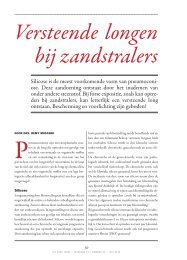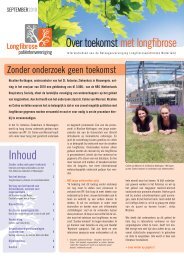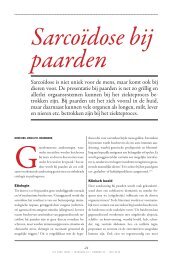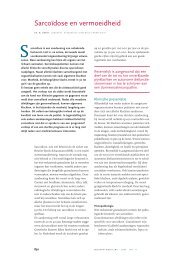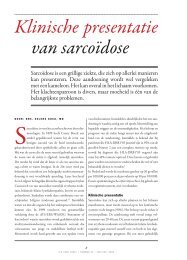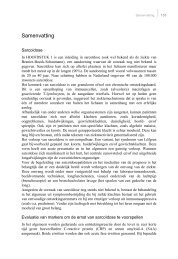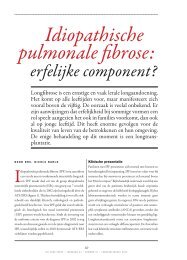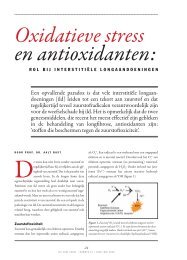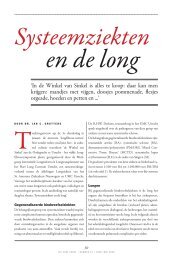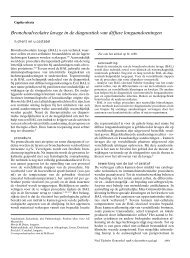Interpretation of bronchoalveolar lavage fluid cytology - ILD care
Interpretation of bronchoalveolar lavage fluid cytology - ILD care
Interpretation of bronchoalveolar lavage fluid cytology - ILD care
You also want an ePaper? Increase the reach of your titles
YUMPU automatically turns print PDFs into web optimized ePapers that Google loves.
<strong>Interpretation</strong> <strong>of</strong> BALF <strong>cytology</strong><br />
which represents the only coefficients influenced by the relative sizes <strong>of</strong> the diagnostic groups. For predicting the<br />
group memberships <strong>of</strong> patients in a population whose diagnostic group have other relative sizes (e.g., Nj /NJ0),<br />
then β ∧<br />
0 j coefficients have to be adapted as follows:<br />
β ∧<br />
0 j(new)= β ∧<br />
0 j - ln(nj /nJ ) + ln(Nj /NJ ) (5)<br />
In our application with three diagnostic groups (J = 3), we had two linear predictors, <strong>of</strong> which the estimated ßcoefficients<br />
and standard errors are presented in Table 2.<br />
Table 2.- Estimated coefficients and standard errors (SE) <strong>of</strong> the polychotomous logistic regression model.<br />
Explanatory variable F1 SE F2 SE<br />
Constant 11.68 4.26 16.19 5.51<br />
Age yr -0.2072 0.05 -0.1406 0.05<br />
Sex (female) 0.7863 0.82 0.9682 1.01<br />
Smoking (yes) 2.389 2.65 -0.9572 3.15<br />
Smoking x (age 2 ) -0.4481x10 -3<br />
0.82x10 -3<br />
0.8495x10 -3<br />
0.11x10 -2<br />
BALF<br />
Yield(out/in)x100 0.0672 0.04 -0.0310 0.04<br />
Cells x10 4 .mL -1<br />
-0.0764 0.02 -0.0120 0.02<br />
AMs %; squared -0.2913x10 -3<br />
0.41x10 -3<br />
-0.2009x10 -2<br />
0.82x10 -3<br />
PMNs %; squared 0.5536x10 -3<br />
0.55x10 -3<br />
-0.2613x10 -2<br />
0.22x10 -2<br />
Lym %; squared 0.1465x10 -2<br />
0.13x10 -2<br />
0.6466x10 -3 0.15x10 -2<br />
Eos %; squared -0.1986 0.0623 -0.0109 0.0116<br />
Definition <strong>of</strong> abbreviations: F1=function 1; F2=function 2; AMs=alveolar macrophages;<br />
PMNs=polymorphonuclear neutrophils; Lym=lymphocytes; Eos=eosinophils.<br />
After the logistic regression analysis was done, a computer program was created according to the regression<br />
model. This program was tested by predicting <strong>ILD</strong>, using the population mentioned earlier, that had one <strong>of</strong> the three<br />
<strong>ILD</strong> from another hospital, that we investigated.<br />
Results<br />
Table 3 contains the results <strong>of</strong> BALF-cell analyses <strong>of</strong> the control subjects and patients with sarcoidosis, EAA, or IPF.<br />
Since statistically significant differences were found among nonsmokers (NSm) and smokers (Sm) within the<br />
studied groups, these data are shown separately. The data are presented as mean values ± SEM.<br />
The classification results for both the learning set and the test set are listed in Table 4. These results were obtained<br />
by applying the allocation rule as described earlier. A polychotomous logistic regression analysis was performed on<br />
the data for the <strong>ILD</strong> patients. In this group <strong>of</strong> 277 patients (the learning set), the computer prediction resulted in a<br />
different outcome (i.e., the highest likelihood for 24 patients <strong>of</strong> a particular diagnosis) than did physicians' judgment<br />
based on anamnesis and various tests (mainly biopsy; see Table 4).<br />
The rate <strong>of</strong> accuracy <strong>of</strong> classification was independent <strong>of</strong> the type <strong>of</strong> <strong>ILD</strong>, and no patient was excluded because <strong>of</strong><br />
outlying parameters. Moreover, when the outcome <strong>of</strong> the program differed from the physician's judgment, the<br />
program expressed doubt, and in most cases calculated a substantial percentage, although not the highest, toward<br />
the correct diagnosis. Thereafter, in order to test the predictive power <strong>of</strong> the model, the patient population from the<br />
other hospital in the study was used. In the latter group <strong>of</strong> 128 patients (test set), the computer prediction gave a<br />
different outcome for seven patients than did physicians' judgment (Table 4).<br />
S<strong>of</strong>tware to evaluate BALF analysis. Drent et al. Am J Respir Crit Care Med 1996.<br />
5



